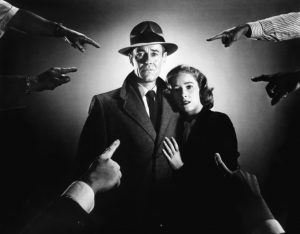
 Over the next two months, Film Forum is showing the complete films of both Alfred Hitchcock and Francois Truffaut. In honor of this pairing, we will preview the Hitchcock films using insights from the directors’ own conversations in Hitchcock/Truffaut, Truffaut’s landmark book of interviews.
Over the next two months, Film Forum is showing the complete films of both Alfred Hitchcock and Francois Truffaut. In honor of this pairing, we will preview the Hitchcock films using insights from the directors’ own conversations in Hitchcock/Truffaut, Truffaut’s landmark book of interviews.
On Tuesday, Film Forum’s Complete Hitchcock series will pull a complete 180, transitioning from the fluffy, Technicolor, French Riviera-set “To Catch a Thief” to arguably Hitchcock’s most solemn film, the black and white “The Wrong Man.” One of the only traditional Hitchcock touches is his cameo, but instead of providing a moment of levity or incongruity as in most of his films, in “The Wrong Man,” Hitchcock appears at the very onset of the film to announce that “every word is true.”
The true story is that of Christopher Emmanuel Balestrero, played by Henry Fonda, a mild-mannered musician and family man who is accused of a string of robberies. Manny is almost impossibly pure; despite working in a nightclub, he doesn’t drink, and despite looking at the horse races in the paper every day, he never actually bets and says he just likes the arithmetic. But though Manny may be a good husband, father, and citizen, he also bears an uncanny resemblance to a neighborhood stick-up man. The police apprehend Manny and bring him around to the businesses that have been robbed. Every single witness says Manny is guilty.
Manny’s family and friends are loyal to him and try to help, but the police and the community at large are convinced of his guilt. Rose, Manny’s loving wife played by Vera Miles, begins to crack under the psychological strain of both the accusations and the money troubles that the bail money and lawyer fees exacerbate. By the time Manny is brought to trial, Rose has had a breakdown and is in a sanatorium. Eventually, the police catch the real robber and Manny is freed, but it takes two more years for Rose to recover and leave the sanatorium.
Hitchcock abandoned his usual style to film this story in a remarkably documentary-like fashion. In his interview with Truffaut, he reveals how he used many of the locations in Manhattan and Queens where the real incidents took place and even used some of the real participants. He even studied real prisoners to see how they handled their bedding and clothes. Some scenes, such as the capture of the real robber, follow their real life counterparts down to the slightest detail, like the storekeeper stamping her foot to alert her husband and the robber whining that his wife and kids are waiting for him.
That last comment highlights what makes this film stand out among Hitchcock’s work. The details of working class family life are shown so accurately and compassionately that the film has an almost neo-realist feel. We know Manny’s salary, his responsibilities, which insurance policies he’s borrowed against.
Truffaut seemed to somewhat dislike the film, telling Hitchcock, “your style, which has found its perfection in the fictional area, happens to be in total conflict with the esthetics of the documentary and that contradiction is apparent throughout the picture.” Hitchcock admits that his “faithfulness to the original story resulted in some deficiencies in the film’s construction,” but defended his more commercial stylistic choices. Truffaut, from his European perspective, seems to want an even more neo-realist style, leading Hitchcock to complain, “You want me to direct for the art houses.” (Truffaut responds, “Of course not.”)
“The Wrong Man” remains a worthy film neither as an exemplar of Hitchcock’s style nor as a totally strict documentary style drama, but rather as an intriguing mixture of the two styles. “The Wrong Man” plays Tuesday at Film Forum.